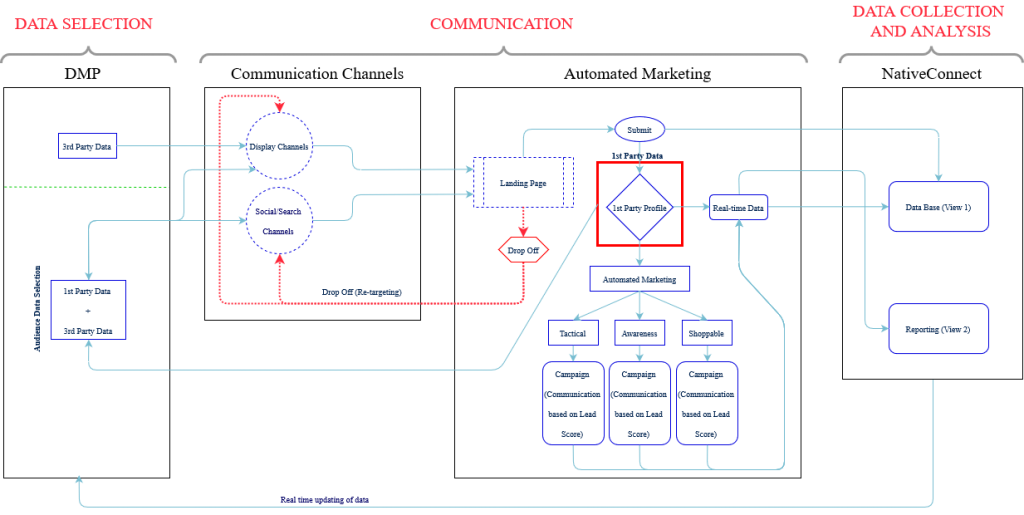
Data – The Key Ingredient in Programmatic Marketing – Part II
How can advertisers use this data to stay ahead of the curb?
Advertising is a rapidly evolving landscape. Keeping tabs on consumer mindsets and behaviours online and offline, is crucial. Programmatic marketing helps you track the efficiency of your advertising campaign. You can determine the exact efficiency of an ad on Facebook towards a consumer’s final decision to buy your product. This is where the concept of a seamless ad experience comes in.
Here’s a Scenario:
You are looking to buy your wife an expensive gift for her birthday. You begin scouring through multiple websites to find something she would love! You begin your search on Google and are lead to multiple haute couture e-commerce brands. On visiting these websites, you are profiled as a big spender for luxury goods. You suddenly get a business call and close your browser. A few hours later, on your way to a meeting, you continue your search for the perfect gift but you notice luxury automotive ads on the various websites you visit.
After work, while browsing through your instagram feed you start noticing the same luxury automotive ads from before…strange! You click on one of the luxury automotive ads to register your interest. Moments later, your phone beeps with an email confirming your details and a personalised invite to the launch of a new model. The very next day, you get a call from a sales representative to schedule a test drive.
When you meet with the sales team, they seem to know your preferences and address every concern you have. This leaves you more convinced to make this purchase. A few weeks later, the car is yours! But, it’s not over yet! A few days later, you start seeing ads on car accessories for the same model you just purchased, you visit the website to know more about these accessories. Simultaneously, you also receive an email with a personalized offer for the accessories. You’re ecstatic not only because you’ve earned those brownie points with the wife but also because your buying experience was seamless.
This is only one side of the story.

Now imagine you are the marketing manager for the luxury automotive brand. Your main goal is to break down the barriers to siloed data. You need a place to centralise this data and make sense of it. You have recently acquired a data management platform (DMP) to centralise and make sense of your organisations first-party data, thus breaking down the siloed barriers. This allows you to identify where your potential customers are, across your owned media channels in order to profile and target them with personalised messaging and look for profiles that closely match your buyers’ personas.
Users who have previously visited your owned media channels are then categorised. This information will allow you to understand where in their customer journey they are and target or retarget them accordingly. Through the power of exclusion, we are able to exclude our converted audiences from seeing any communication that is not relevant based on their customer journey which in turn reduces ad wastage and maintains the brand’s image.
The audiences that do convert from our paid media activities will be added to the CRM system which is also linked to our automated marketing campaign where, based on their preferences, they will be added into appropriate automated email campaigns and nurtured. The aim of automated email marketing is to communicate directly to our first-party audiences with trigger-based messaging, as opposed to sending bulk or irrelevant communications, which are often dismissed or can affect the brand’s image, negatively. Each of our first-party audiences are assigned lead score which allows for the sales team to evaluate the readiness of a potential buyer and to minimise human interaction until a point where it is necessary.
Through ad trackers and attribution modeling we are able to identify the various touch-points which lead to a conversion, enabling you to rank communication channels in terms of effectiveness and determine the most appropriate channel(s) and budget when planning for future campaigns.
Acquiring a new customer can cost 5x more than retaining an existing customer. Through the nurturing process we are able to understand our existing customers’ preferences gradually through progressive profiling, thus empowering us to up-sell/cross-sell to our existing customers.
In summary:
- Programmatic marketing delivers across screen displays. Programmatic buying allows advertisers to reach a variety of websites and devices simultaneously
- It helps measure campaign success accurately
- Programmatic buying allows advertisers to measure the results of an advertising campaign in real time. This makes it easy to both tailor ad campaign goals and content mid-way through, if the results aren’t as promising as initially projected. This increases efficiency in advertising campaigns and lowers production cost
Challenges:
- Let’s say that an advertiser purchases display ads through programmatic. While the URLs might look and sound legitimate, advertisers must be wary of the quality and reach of the space – what reads like a good URL might be a low-quality webpage or out-of-use altogether
- Programmatic buying companies usually sell the same space to different advertisers, causing a physical overlap in advertisements on websites, making one or both unreadable, un-clickable and essentially useless. Especially if these advertisements have audio or video components, or if audio or video files are intrusive, online viewers are more likely to have negative feelings towards the brand.
- It is not always accurate, with the rise of ‘click farms’ where publishers might take a low budget rental space and hire local staff to click on ads
In conclusion, programmatic advertising is now becoming a universal practice with advertisers expanding their focus across various channels and devices. The seemingly overwhelming industry jargon is being surpassed by the programmatic promise of efficiently and systematically advertising to people based on their unique traits.




